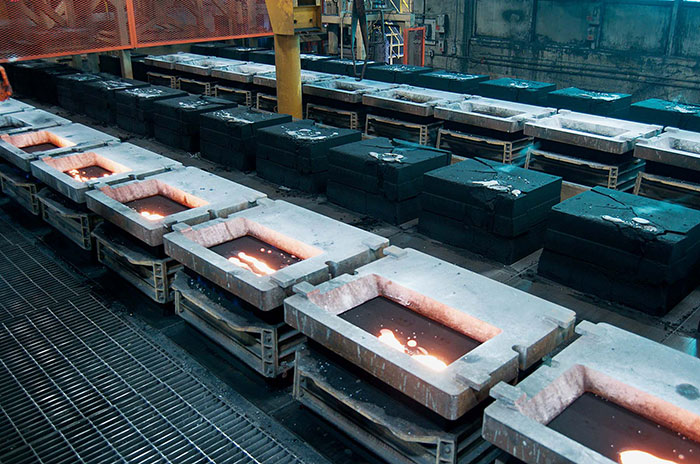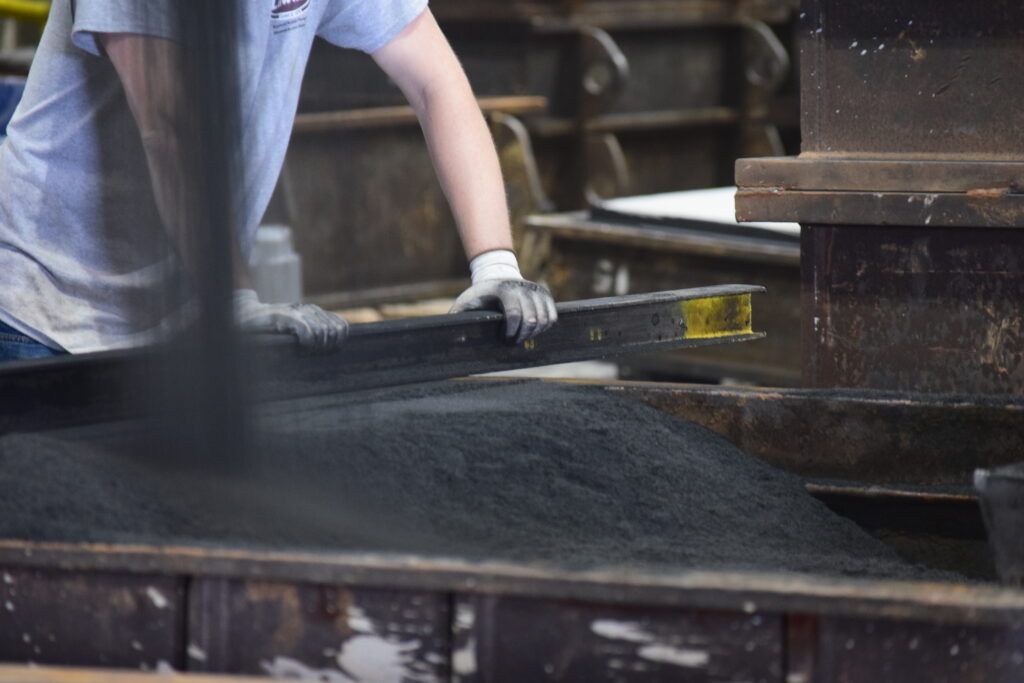
It’s not actually green, but it sure is alive.
Green sand molding is used in two of our foundries at Lawton Standard. It helps to create smooth finishes on our high-quality castings and it’s very sustainable and environmentally friendly.
We had the chance to catch up with Lawton Standard casting engineer Lauren Innis to discuss the green sand molding process.
What is green sand molding?
The process basically takes sand from a lake, cleans it and makes it into the size we need for an appropriate casting. “Then we’ll take that sand,” said Innis, “and we’ll add an additive called bond. The bond contains several different materials, it contains bentonite clay, it can often contain cereals or cellulose, it can contain seacoal. The additives help improve the flowability, strength and other properties of green sand.”
The cereals and cellulose help increase the toughness of green sand. Those can be oat, wood or corn additions to the green sand system.
“We’re basically coating the sand grains with the bond and then adding the water to activate the clay,” said Innis. “That gives you the ability for the green sand grains, the green sand, to form together into a really strong mold.”
After that process, pressure is applied to the green sand to create a mold.
Why is it called “green” sand?
If you head into the foundry in search of green-colored sand, you may be searching for a long time.
The sand used in this process is called “green sand,” but the sand is actually not colored green.
The reason behind the name is because the sand has water/moisture in it, similar to the description of green wood. Green sand is typically black or grey in color.

Green sand vs. furan sand molding
“Green sand molding can create really good surface finishes,” said Innis. She said it also pulls away from the cooling very well and creates less burn-in sand.
Every foundry has its own unique green sand blend, it all depends on their customers, the materials they are making and what kind of tolerances they have. Currently two Lawton facilities use the green sand molding process: Northern Iron in St. Paul, Minnesota and Renaissance Manufacturing Group in Anniston, Alabama.
Innis said “green sand can be advantageous over furan for some specific types of products. For something you’re creating a lot of them, green sand molding process is great, because it’s less expensive than furan and it can be reused.”
Innis says a well-maintained green sand system is not going to swell or change your dimensions significantly different than a furan molding system.
Green sand systems are generally used in shops that do more volume. “You’re going to be using that green sand system, when you have that more consistent running mold machines versus floor molding, because it has to be used relatively quickly,” said Innis.
She continued “Furan, it can sit for a while and you mix it whenever you’re going to use it, whereas green sand systems you have to keep running.”
When it comes to green sand vs. furan, Innis says they’re both great for different purposes. “When you’re making a big mold, a really large part, like at C.A. Lawton-Minster, you need to put complex cores in it, you need to double and triple check that it’s right and you got one chance to do it… that’s a really good application for furan,” said Innis.
“But if you’re making 10,000, even 1,000, parts in a year, you want them all to be geometrically similar, you want them manufactured quickly, you don’t want to have a lot of cost and overhead… green sand molding is a really good opportunity for that.”


Keeping the green sand system healthy
“The green sand system is a living system, so we continuously monitor it, we continuously maintain the system, we test the system’s health,” said Innis.
Innis continued “We look at a ton of different properties in our green sand. The methylene blue test is a specific test that we do to look at the amount of active clay in the system.”
Other things Lawton does to keep the system healthy are to read temperatures, take AFS clay measurements, as well as doing sand screen tests. “This helps us look at the distribution of sand grains across different screens,” said Innis. “And it helps us make sure we have a good casting finish with just the right amount of fines to give it a smooth surface.”
Temperature is also critical in the green sand mold process. “We want it warm enough that it’s formable and it’s able to flow easily, but also we don’t want it to be too hot, because we don’t want to generate burn-on sand,” said Innis.
Innis said at our Northern Iron facility they use a fluidized bed cooler to cool the sand before it goes back into the mullers on the 30 square green sand molding line.


Green sand is highly reusable and recyclable
“The great benefit about green sand is that it’s really reusable,” said Innis.
The green sand goes through the system and gets shaken out and separated from the casting and it’s reused over and over again. “A piece of sand can go through the system ten times or even more depending on where it is in the mold.” said Innis. “If it’s really close to the casting, it will tend to break down more quickly, but if it’s farther away from the casting, it can be reused for quite a long time.”
Along with our green sand systems, both Northern Iron and RMG have dust collectors on the floor that pull all of the “fines,” which are super fine grains of sand, out of the system. Those “fines” can beneficially be reused in some cases and the “fines” are also very easy to recycle.
“If you think about it,” started Innis. “Basically everything in the green sand molding system came from the earth at some point, right? It’s seacoal and sand and bentonite clay, maybe very little cereals that are manmade, but everything is basically things we found in the ground and combined them in the right way.”

The future of green sand is bright
Lawton Standard participates in the AFS 4M Green Sand Committee. This committee helps us learn about new and upcoming technologies in green sand molding. It also improves our testing and gives us access to a number of industry experts to help us improve our operations.
Lawton also works closely with our suppliers and vendors at both Northern Iron and RMG, in an effort to make improvements to our green sand systems and better serve our customers.
We also supplement our in-house testing with external sand laboratory testing from our vendors. This helps give us continuous monitoring of the green sand systems.
Turn to Lawton Standard for your high-quality casting needs
As we mentioned, Lawton has two facilities, Northern Iron and RMG, that utilize green sand molding systems. In total, Lawton Standard has 5 foundries that produce high-quality iron castings and 1 foundry that produces high-quality steel and stainless steel castings.
For more on our operations or if you are interested in getting a quote, give us a call at 920-337-2448.
